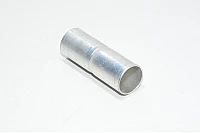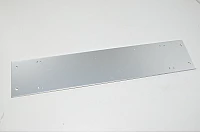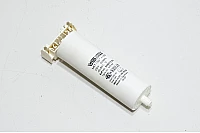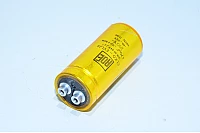470µF 250VDC 85°C ROE (Roederstein) ELKO-EYL/A aluminium electrolytic capacitor, M5 terminals
- Manufacturer:

ROE (Roederstein, nowdays Vishay) - Model:
ROE (Roederstein) ELKO-EYL/A 470µF 250VDC - Dimension:
85 x 35 x 35 mm - Weight:
102 g - Availability: 1pcs
- Condition: Used
-
Price Including VAT: 15,06€
- Ex Tax: 12€
Aluminium electrolytic capacitors offer large capacitance in small dimensions. They are mainly used in power supplies as filtering capacitors, but they can be used in numerous other applications as well, which require capacitors ranging from millifarads to microfarads. This capacitor stability is although weak, so they are not suitable for application requiring precision. Nor Electrolytic capacitor are suitable for high frequency applications due to their large losses. They also age faster faster that other components and their cold resistance is weakish.
Aluminium electrolytic capacitor plates are thin aluminium foils, which has a glycol based electrolyte soaked paper in between of them. These layers are rolled as roll and closed into electrolyte filled container. When capacitor is connected into directed current, an oxide film (Al2O3) will form on anode ie positive plate surface. This layer thickness depends partially from voltage, so capacitance tolerance is large as well. Electrolytic fluid acts as a cathode, which is in contact with another aluminium foil.
Regeneration of electrolytic capacitor electrode's oxide layer:
Capacitor which has not been used for a long time might lose it's oxide layer, when it has to be fixed by supplying direct current to the capacitor through couple of kilo-ohm resistors. In case the resistor is not used, current can increase as much before the oxide layer has yet formed, that the capacitor will be destroyed the same way as an aluminum electrolytic capacitor connected with reverse polarity or with an alternating current.
We do recommend this oxide layer repair to be done for every electrolytic capacitors. Especially for those which go into the circuit between the supply voltages. Since in case of a short circuit event (depending on the circuit) there is as much current available as will the fuse or some other component allow. Repairing should be done with an adjustable power supply and the repair work is started with small voltage (for example 1/3 of the capacitor rated voltage). Slowly the voltage can be increased up to the level of capacitor's rated voltage. With adjustable lab power supply you can set a certain current limit, when an external series resistor is not needed. Power supply max current can be calculated with Ohm's law same way as if you would supply current through series resistor from a fixed voltage. By observing the current flowing into the capacitor you will notice that it will start to decrease compared to the initial state, as the oxide layer regenerates. It has been stated that 20-60min should be a sufficient repair time for this treatment. if you are reforming multiple pieces of same capacitors at the same session, you can monitor the oxide layer condition and that the regeneration is finished by observing the current flow.
Capacitor technical details:
- Capacitor type:
- Aluminium electrolytic capacitor
- CR (rated capacitance):
- 470µF -10%/+30%
- Ur Rated operating voltage:
- 250VDC
- Upeak (max peak voltage):
- No info
- ESRtyp (typical Equivalent Series Resistance):
- No info
- Zmax (max impedance):
- No info
- IAC,max (max alternating ripple current):
- No info
- IAC,R (rated alternating ripple current):
- No info
- ESL (Equivalent Series Inductance):
- No info
- tan δ (dissipation factor):
- No info
- Expected service life:
- No info
- Tamb,max (rated max ambient temperature):
- 85°C
- Safety vent:
- Yes
- Operating temperature range:
- -40°C...85°C
- Connector terminals:
- M5x0.8 screw terminals
- Terminal pitch:
- 13mm
- Dimensions:
- Height:
- 85mm
- Diameter:
- 35mm
- Height:
Tags: 250VDC, 470uF, ROE, Röderstein, Roederstein, cap, capacitor, EYL-series, aluminium electrolytic capacitor
Recently viewed
Price Inc. Tax: 15,06€ Price Ex. Tax: 12€
Availability: 1







